It would be a day of heat; any wind would do. There seemed to be a light west wind most favorable for my sail to the Northeast Point of Bull Island. I had imagined that I would need to paddle, and recalled several times in the past paddling in no wind and much heat. Once underway, I found little need to use the paddle except as an occasional spar to hold the boom out.
The slow movement in light wind was meditative. My senses adjusted to the sights and sounds in the creek. The creek sides were green walls of Spartina monoculture and a brown underpinning of oyster banks. And here and there the white figure of a great egret stood erect. Above was a background of blue skies splashed with white clouds, illuminating the flight of birds. The mainland sounds faded, and as the wind dropped the hissing of Kingfisher’s hull quieted. A wood stork passed over one of the egrets in its flight toward Bulls Bay. Occasionally a fishing boat motored past in the creek. The outlet to the Bay was not just a geographic border but a sonic one: the soft murmur of surf in the distance filled in.
The hiss came back to the hull crossing the Bay heading east southeast. A brown pelican crashed into the still waters astern, and terns passed overhead. Closer to the island a loggerhead came up for a breath; what a breathless summer for loggerhead nesting in Cape Romain – over 3500 nests eclipsing the old historical record of 2500 (2017). A pair of waterfowl flew toward the mainland, their red beaks prominent.
The landing at the Point was easy, and no other boats or people were present. My last sail here had lots of company – just a couple of boats but a double Beach Drop had almost a hundred people on the beach all the way down to the Boneyard. I appreciated the solitude with no footprints before me as I strode off.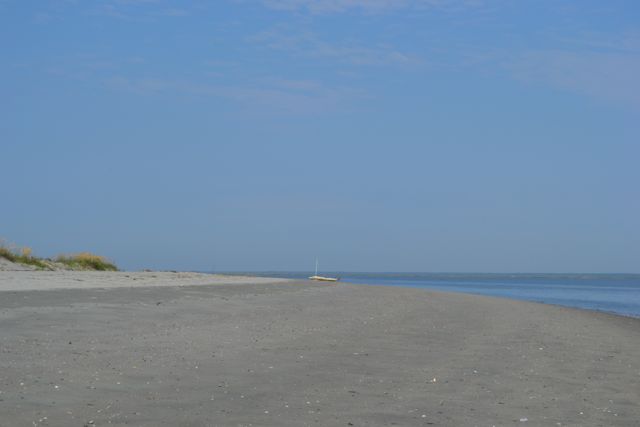
There was quite a human artifact around the Point – a thirty-some-foot stranded sailboat in the gully. It must have been a sad last sail for the owner of this craft.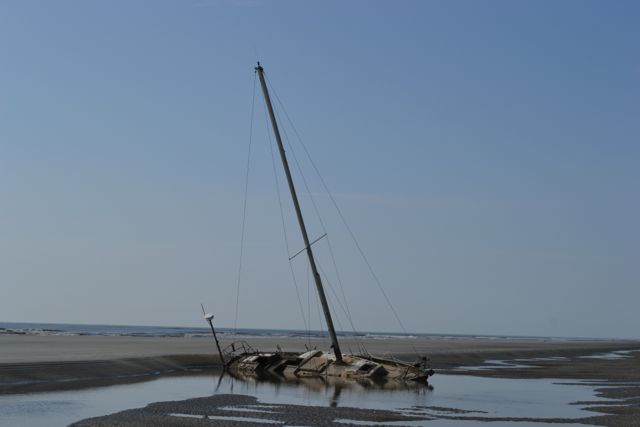
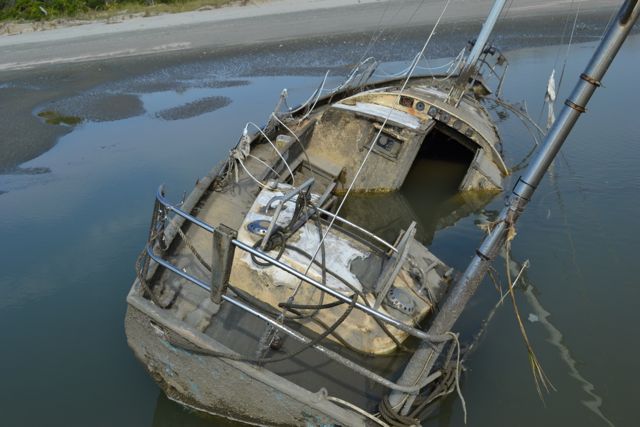 It was not salvageable: the hull was filled with sand and water. There is another fiberglass hulk about half a mile south of the entrance to the Beach Road. These hulls will not move far until future storms and associated tides rearrange the shoreline.
It was not salvageable: the hull was filled with sand and water. There is another fiberglass hulk about half a mile south of the entrance to the Beach Road. These hulls will not move far until future storms and associated tides rearrange the shoreline.
The walk would take me through the maritime forest and connect with the dike around the Jacks Creek impoundment. I started off with long pants, and added a long sleeve shirt before crossing the dune field and accessing the entrance to the forest. The transition was stark, and the tunnel of the forest closed in further as a horde of biting deer flies and mosquitoes attacked. I would have been a goner without hat and long sleeves; my face and hands still presented ripe targets. The assault was not over once on the dike, but lessened as I finally reached a more open section.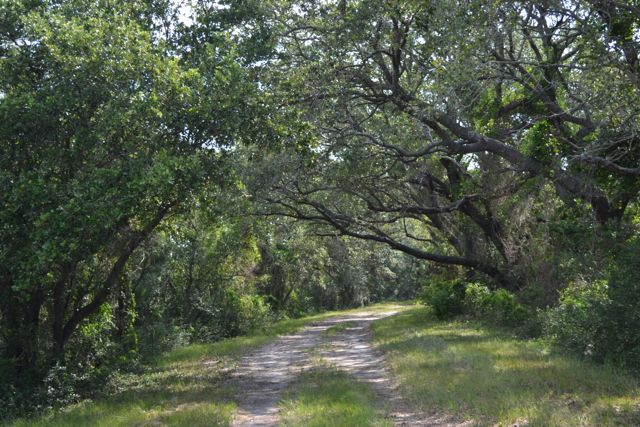
The sounds of bird life came from the impoundment to my left. Staying on the move, I soon found myself trailing an animal walking in the same direction perhaps fifty yards ahead. I eliminated a number of mammals from the possibilities: raccoon, fox, otter, coyote. Bobcat?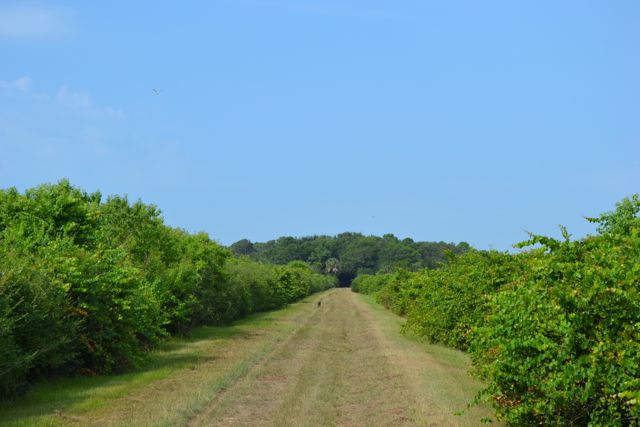 I took one photo, and made all haste to change to a longer lens. But by that time the animal had slipped off into the shrub-covered side of the dike. The animal was forgotten as I continued the walk, then out of the corner of my eye came a flash of an adult feline and the sound of its rapid scramble into the shrub zone. After walking the island for years, I had finally seen a bobcat. The experience reinforced the effort of walking miles on the island, at times in unpleasant circumstance, i.e. biting insects.
I took one photo, and made all haste to change to a longer lens. But by that time the animal had slipped off into the shrub-covered side of the dike. The animal was forgotten as I continued the walk, then out of the corner of my eye came a flash of an adult feline and the sound of its rapid scramble into the shrub zone. After walking the island for years, I had finally seen a bobcat. The experience reinforced the effort of walking miles on the island, at times in unpleasant circumstance, i.e. biting insects.
Past the site of the “Old Fort”, I cut across and onto the cross dike that now bisects Jacks Creek. The heat had already risen, but some cloud cover and the hint of a sea breeze provided a small relief. And mostly the flies and mosquitoes were left behind. But birds were everywhere. Jacks Creek has been one of the few places I have seen black-necked stilts, and both adults and their young flew along and landed on the edge of the dike.
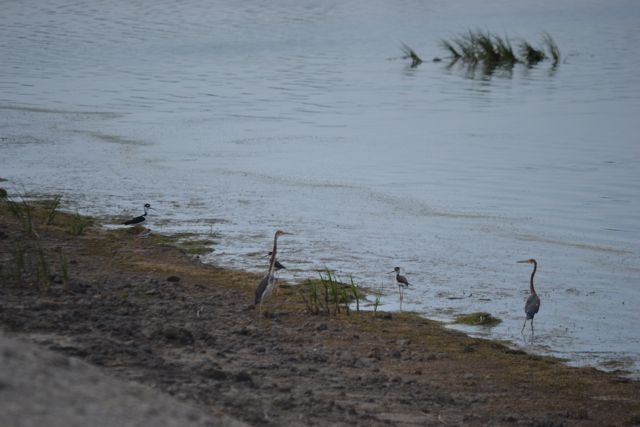 Black-necked stilts and tricolored herons
Black-necked stilts and tricolored herons
This new dike has already eroded at a curve from the action of wind and waves, and the placement of bags of cement have hardened both sides of this curve. It was almost half way across the dike that I saw the first alligator. A second announced its presence through an explosion of water and mud, and others appeared regularly on the freshwater side of the impoundment. Anhinga and osprey flew over the waters, and more birds stood along the dike’s edge: egrets (great and snowy), tricolor herons, great blue herons, and a pair of the waterfowl seen earlier, black-bellied whistling-ducks. 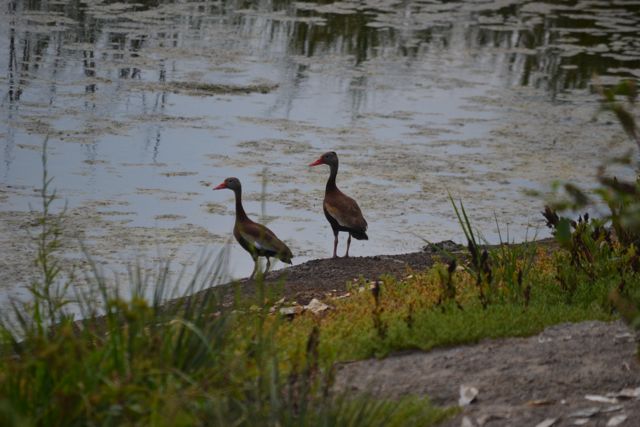
These goose-like ducks are a new bird species for me. (Confirmation of the ID via this photo from bird expert David McLean.) It was a memorable experience – the awareness of another species, seen twice on this day. So where do I fit in the bird/nerd hierarchy? I heard an excellent talk by Drew Lanham about birds in May, and he polled the audience concerning how they self-identified. Bird observer for me. But over the years my observing has grown as I have become more familiar with the bird world in my neighborhood, and in Cape Romain. One of many remarks Lanham made that resounded with me was not taking any bird for granted, even the most common. He mentioned cardinals as an example. What of brown pelicans, whose decline had caused alarm in the twentieth century? Ospreys? Great egrets? Cape Romain National Wildlife Refuge provides habitat for a range of wildlife including endangered and threatened species, and its importance for the many species of birds can inspire us all to defend it.
I continued on to the Lighthouse Road dike and the dike breached at New Pond near the Boneyard. Heading north on the beach to complete the loop, I encountered several groups of roosting birds at the low tide line: pelicans, terns, gulls.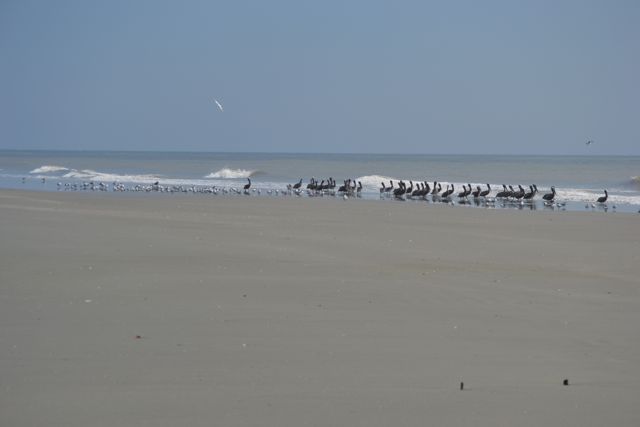
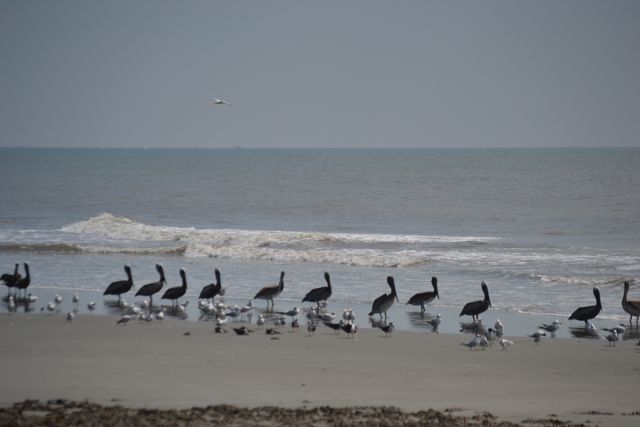 The area of the shallow ponds between the beach and the Jack’s Creek dike was posted Closed due to shorebird nesting. Down the beach, the mast of the stranded sailboat has become a new landmark. I also noticed what appeared to be an ATV, and stopped to talk to Melissa Bimbi, USFWS staff person (and the only person seen on the island this day). She was preparing to take down the Closed Area posting fence at the Point, since bird nesting here has finished for the season.
The area of the shallow ponds between the beach and the Jack’s Creek dike was posted Closed due to shorebird nesting. Down the beach, the mast of the stranded sailboat has become a new landmark. I also noticed what appeared to be an ATV, and stopped to talk to Melissa Bimbi, USFWS staff person (and the only person seen on the island this day). She was preparing to take down the Closed Area posting fence at the Point, since bird nesting here has finished for the season.
The wind was light to moderate, but a shift to the southwest presented me an easy sail all the way on the port tack for the homeward leg. It was most appreciated, since the heat had sapped energy from this aging sailor. Before leaving the Bay, a flight of fourteen black skimmers flew out of the creek and followed my wake toward the island. The skimmers have been nesting in the refuge, and hopefully have been successful in bringing more skimmers into the world.
Post sail
I could no longer avoid a significant problem with Kingfisher. My friend Billy Baldwin in McClellanville once asked me why did I keep fixing up my old boat? Replace it! Well, I guess it is in my DNA to repair. He will get a laugh out of this last photo. 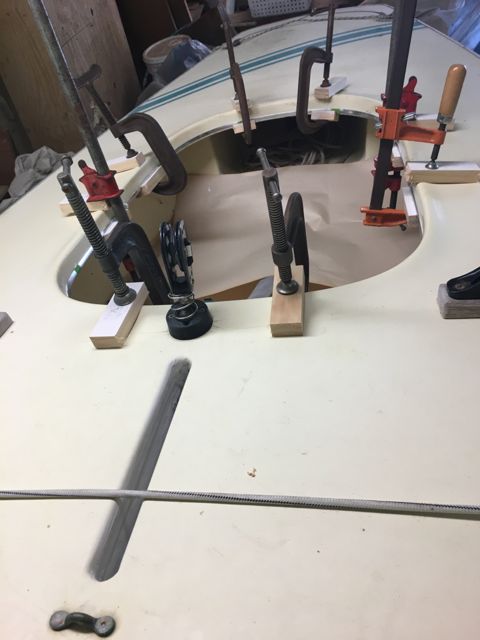
lovely photos!!!!! and the Kingfisher will always keep you company!!!!!
Yes she will, but needs some attention.
Thanks, Bob. I so appreciate the poetic expressions of your experience. I know of the areas you have brought to life for me……makes me want to return. Maybe in the next couple of weeks. Keep writing, we all are nourished by it as we reflect on our own memories of these times and places. It’s the good stuff!
It’s the good stuff, and a wonderful world.
Wonderful Bob! It reminds me or our trip many years ago, It is a beautiful and quite place but those dang bugs.We had blood running down or faces! LOL.
We will be in Myrtle Beach tomorrow. I’d love to do another Bull Island run but sadly the old legs don’t have it anymore.
Ron
Ron, an option for you to get out to the island is Coastal Expeditions’ Beach Drops, which they do on Sundays. The drop is on the Northeast Point where I landed last Friday. So you are on the beach with the only limit on walking being your motivation, condition, and time. Unfortunately on these trips you will miss the “dang bugs” unless you decide to venture into Deer Fly Alley.
Nice post Bob, as usual. It’s been a summer of birdwatching up here in NC since I resurrected our birdfeeder in squirrel-proof mode. We’re also enjoying watching a pair of cardinals care for their 2nd brood of the summer in a shrub only 8 ft. from the screened porch. Highly recommend you treat your island hiking clothes with permethrin to keep the biters away! Repair & reuse-nice job!
Not sure permethrin would slow down deer flies. Come on down and you can field test – I know good places for that.
You are a beautiful writer and illuminate everything around us, thank you for sharing.
And the photos. You’ve inspired Bill and I to get out there.
Yes, every bird counts…
Love that Kingfisher, long may she sail!
Dana
A little bird told me those whistling-ducks have been hanging out in your “backyard”. I’ll be on the lookout.
Thank you.